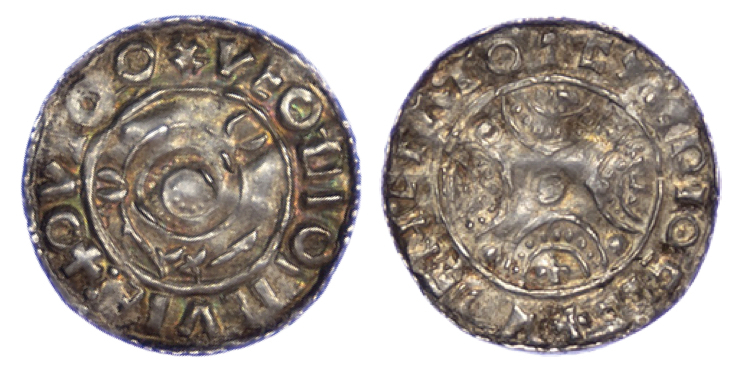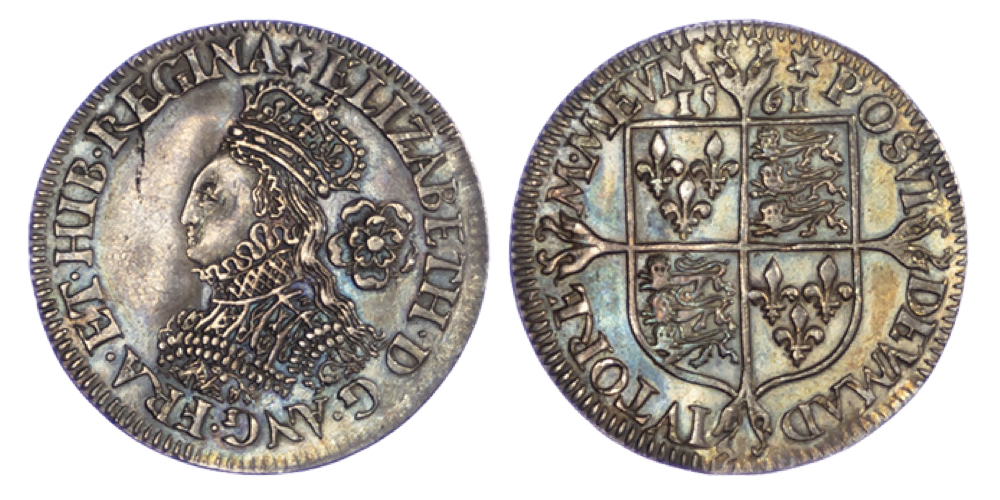Newps from Baldwin's Spring 2020 FPL
 EVillageProwler
Posts: 5,856 ✭✭✭✭✭
EVillageProwler
Posts: 5,856 ✭✭✭✭✭
With the announcement of the new Baldwin's Spring FPL, I am excited to announce my two new purchases from that. (Images are cropped from the PDF file for the listings.)
DENMARK. Knud II den Store (the Great).
1018-1035. AR Penny (1.04g). East Danish standard, early snake type. Lund mint. Serpent curling left, blundered legend / Four double crescents with annulets between arcs, crosses in angles, large pellets at end of arms and in center, blundered legend. Hauberg 20 var. (blundered legends); de Wit 621. Three peck-marks, colorful tone, creased. About VF.
Ex Baldwin’s Spring 2020 FPL, lot 231.
Trade in the North Sea region saw coinage going back and forth from as far west as Ireland to Scandinavia, with England, Scotland and the Northwest Continental European regions (e.g., Brittany, Frankish kingdom, Normandy, Frisia) in between.
Cnut the Great was King of England, Denmark and Norway (and also part of Sweden). He ruled England from 1016 (Denmark from 1018) until 1035. During his rule, the lands under his reign prospered and English coins can be found in Scandinavia and Scandinavia issues can be found in England. (Refer to the EMC database for a comprehensive listing of Scandinavia issues recorded in the UK.)
This type is one of the few issued during Cnut's reign that is not imitative of an Anglo-Saxon type. Hauberg records only 29 coins of this type.
The type displays the iconic Worm on the obverse, likely a representation of the Midgar worm. In Norse mythology, Jörmungandr, meaning "huge monster", also known as the Midgard (World) Serpent is a sea serpent, the middle child of the giantess Angrboða and Loki. According to the Prose Edda, Odin took Loki's three children by Angrboða—the wolf Fenrir, Hel, and Jörmungandr—and tossed Jörmungandr into the great ocean that encircles Midgard. The serpent grew so large that it was able to surround the earth and grasp its own tail. As a result, it received the name of the Midgard Serpent or World Serpent. When it releases its tail, Ragnarök will begin.

GREAT BRITAIN, House of Tudor. Elizabeth I.
1558-1603. AR Sixpence (3.08g). Milled coinage. Tower (London) mint; im: star. Dated 1561. ELIZABETH • D G • ANG • FRA • ET • HIB • REGINA, crowned bust left, wearing ruff; rose to right / POSVI DEVM AD IVTORE M • MEVM, coat-of-arms over long cross fourchée, date above flanking shield. North 20254; SCBC 2593. About EF. Well struck with iridescent toning.
Ex Baldwin’s Spring 2020 FPL, lot 166.
A pleasing example of Elloye Mestrelle’s milled series, which he broadly minted between 1561-71 in his experimental screw press.
The first milled coins in England was issued from 1561 to 1571 for Shillings and smaller. At the same time, hammered types were also issued for some of these denominations.
The following is copied from a Sovereign Rarities lot description (Auction 2, 24 Sep 2019, lot 76):
Elloye Mestrelle likely arrived from Paris with his family in 1559, and along with his sibling Philip was already a skilled engraver. It is thought that he came to England to sell his skills to the Mint, as the Queen was concentrating her energy into the recoinage, having ascended the throne the year before. He may well have lost employment engraving in France, as the first mention of him is in a pardon by Queen Elizabeth of 24th March 1561 where he is forgiven for any treasons, felonies or offences before his arrival at the Mint dating before 1st March 1559. He seems to have secured a contract during 1560 at the Mint, and the first fruits of his experimental machine-made labour appear in late 1561.
To make such milled coins metal ingots were first cast and then a cutter was employed to cut individual blanks, which turned out to be 10% overweight. Therefore, the individual blank flans had to be adjusted by hand cranking through roller presses to flatten them out. The eventual coins were struck by a screw press method and the first denominations were the undated silver Shilling, Groat and Half-Groat, and a limited number of gold Half-Pounds and Crowns perhaps produced to celebrate the Queen's visit to the Mint in July 1561. The silver at least features in a Pyx trial of October 1561, but not the gold. These silver denominations were then dropped in favour of new silver Sixpences, Threepences, Three-Halfpence and Three-Farthings, as of a new Proclamation issued 15th November 1561, all featuring the rose behind the bust, and Elloye was awarded £25 from the Queen.
Elloye worked within the Mint for the next eight years, but fortunes changed on 1st September 1568 when his brother Philip was arrested for counterfeiting Burgundian Crowns and Elloye was implicated in the crime. Philip was subsequently hanged after his conviction of 12th January, and Elloye though once again pardoned on 2nd May 1569 returned to the Mint in 1570; but not in as much favour as previously as he now had only limited access to letter punches for engraving. The Under-Treasurer Stanley suddenly died in December 1571 and the change in master-ship to John Lonison meant changes were afoot. It was decided the experimental machinery would be put to the test against the hammermen in 1572, and its production rate of a mere 22 blank Sixpence sized flans an hour could not compete with the hammermen's 280 in the same timeframe and theirs were more accurately hewn. Therefore, Lonison denied Elloye further access to the Minting area in the Tower though he remained in lodgings with his family, and not much more is known for the succeeding years and months. That is until in October 1577 when Elloye is arrested in London and later appears at the Norfolk Assizes charged with counterfeiting and is convicted. His possessions and family are evicted from the Tower, and alas it seems he met the same fate as his brother Philip in Spring 1578.
For further reading see the article in the British Numismatic Journal 1983, volume 53, "The Milled Coinage of Elizabeth I" by D. G. Borden and I. D. Brown

How does one get a hater to stop hating?
I can be reached at evillageprowler@gmail.com